Gamification and development of a game
VerifiedAdded on 2023/04/07
|9
|1789
|82
AI Summary
This document discusses the recent impacts of gamification in the aviation industry, including the use of gamification in the Frequent Flyer Program. It also analyzes the development of a game for history education, focusing on the chronological order of historic occurrences. The advantages and limitations of the game are also discussed.
Contribute Materials
Your contribution can guide someone’s learning journey. Share your
documents today.
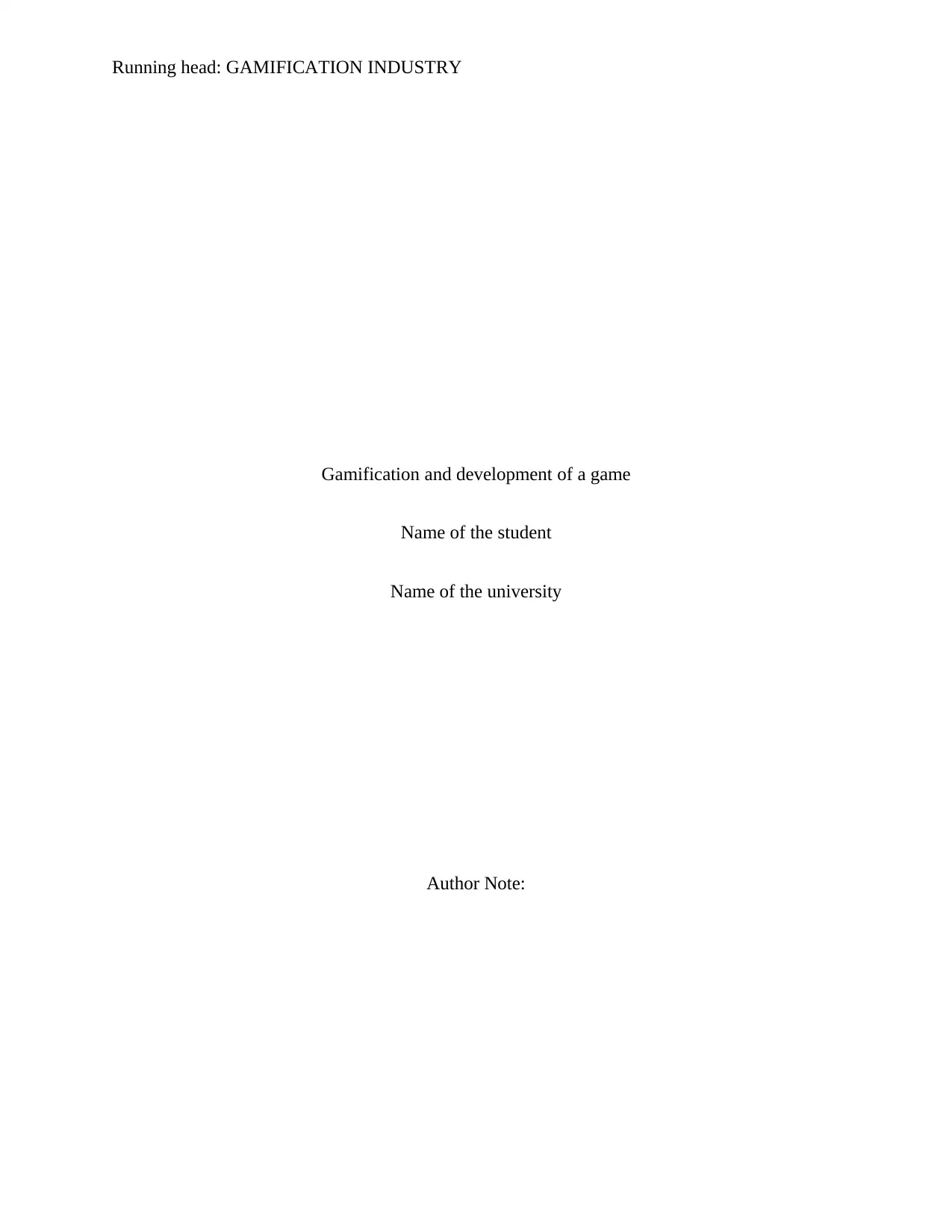
Running head: GAMIFICATION INDUSTRY
Gamification and development of a game
Name of the student
Name of the university
Author Note:
Gamification and development of a game
Name of the student
Name of the university
Author Note:
Secure Best Marks with AI Grader
Need help grading? Try our AI Grader for instant feedback on your assignments.
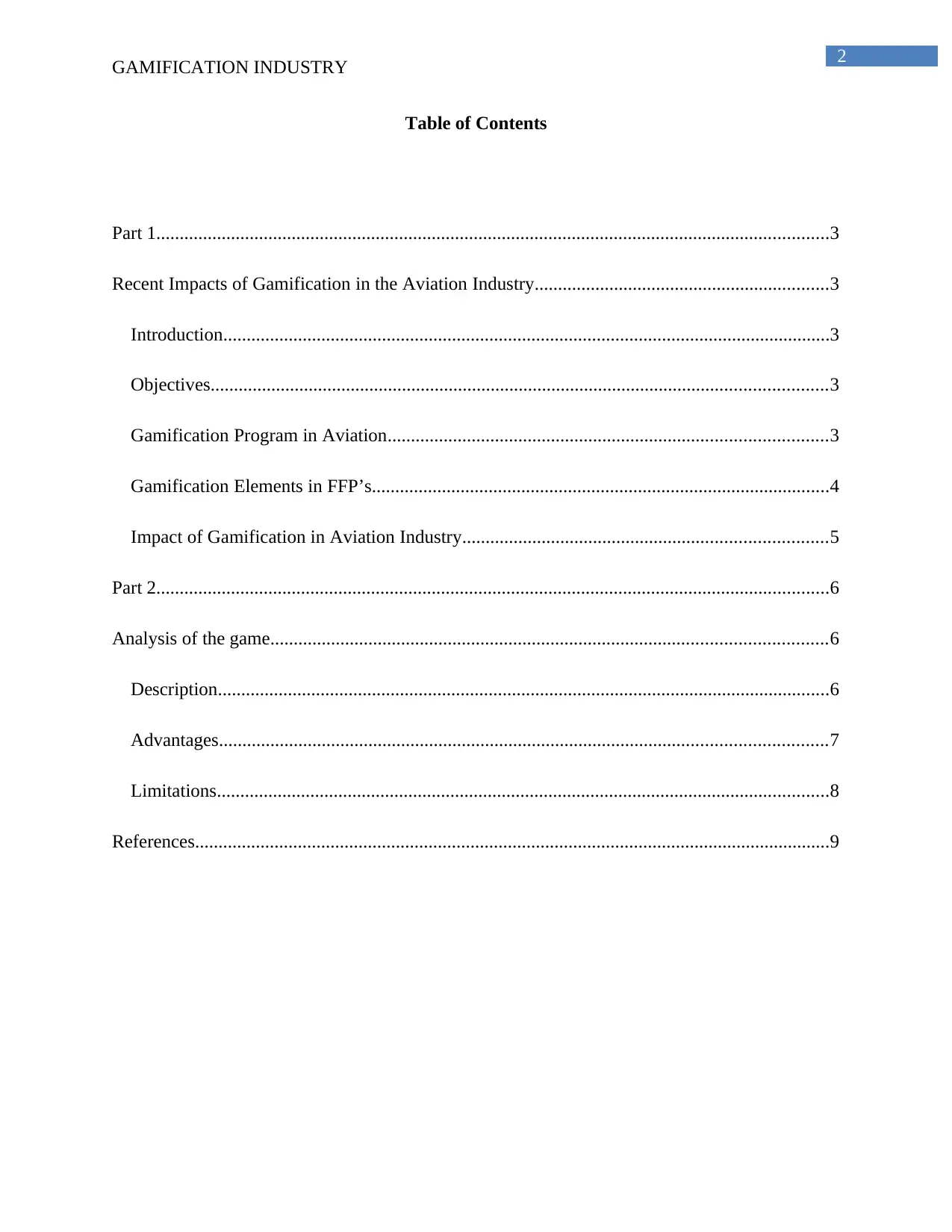
2
GAMIFICATION INDUSTRY
Table of Contents
Part 1................................................................................................................................................3
Recent Impacts of Gamification in the Aviation Industry...............................................................3
Introduction..................................................................................................................................3
Objectives....................................................................................................................................3
Gamification Program in Aviation..............................................................................................3
Gamification Elements in FFP’s..................................................................................................4
Impact of Gamification in Aviation Industry..............................................................................5
Part 2................................................................................................................................................6
Analysis of the game.......................................................................................................................6
Description...................................................................................................................................6
Advantages..................................................................................................................................7
Limitations...................................................................................................................................8
References........................................................................................................................................9
GAMIFICATION INDUSTRY
Table of Contents
Part 1................................................................................................................................................3
Recent Impacts of Gamification in the Aviation Industry...............................................................3
Introduction..................................................................................................................................3
Objectives....................................................................................................................................3
Gamification Program in Aviation..............................................................................................3
Gamification Elements in FFP’s..................................................................................................4
Impact of Gamification in Aviation Industry..............................................................................5
Part 2................................................................................................................................................6
Analysis of the game.......................................................................................................................6
Description...................................................................................................................................6
Advantages..................................................................................................................................7
Limitations...................................................................................................................................8
References........................................................................................................................................9
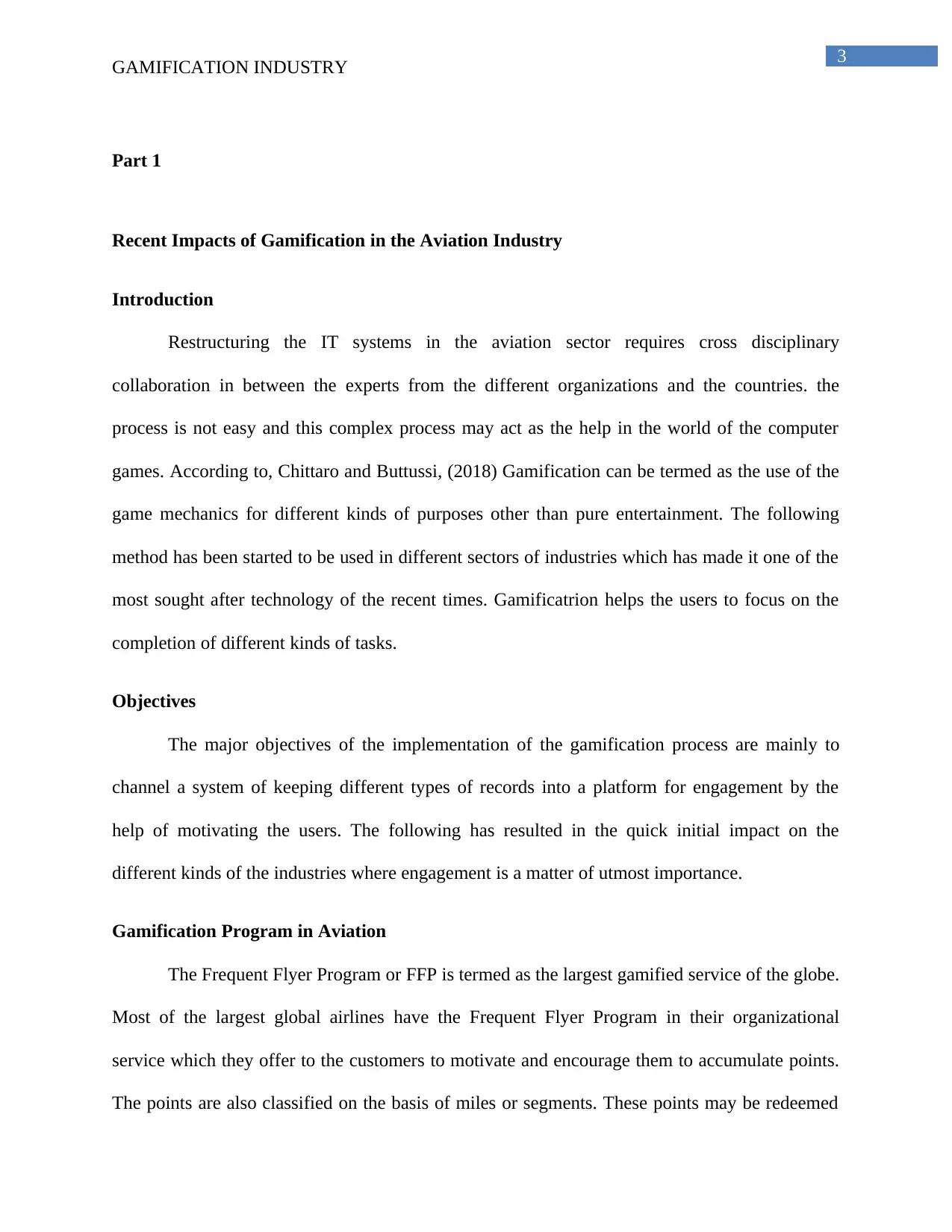
3
GAMIFICATION INDUSTRY
Part 1
Recent Impacts of Gamification in the Aviation Industry
Introduction
Restructuring the IT systems in the aviation sector requires cross disciplinary
collaboration in between the experts from the different organizations and the countries. the
process is not easy and this complex process may act as the help in the world of the computer
games. According to, Chittaro and Buttussi, (2018) Gamification can be termed as the use of the
game mechanics for different kinds of purposes other than pure entertainment. The following
method has been started to be used in different sectors of industries which has made it one of the
most sought after technology of the recent times. Gamificatrion helps the users to focus on the
completion of different kinds of tasks.
Objectives
The major objectives of the implementation of the gamification process are mainly to
channel a system of keeping different types of records into a platform for engagement by the
help of motivating the users. The following has resulted in the quick initial impact on the
different kinds of the industries where engagement is a matter of utmost importance.
Gamification Program in Aviation
The Frequent Flyer Program or FFP is termed as the largest gamified service of the globe.
Most of the largest global airlines have the Frequent Flyer Program in their organizational
service which they offer to the customers to motivate and encourage them to accumulate points.
The points are also classified on the basis of miles or segments. These points may be redeemed
GAMIFICATION INDUSTRY
Part 1
Recent Impacts of Gamification in the Aviation Industry
Introduction
Restructuring the IT systems in the aviation sector requires cross disciplinary
collaboration in between the experts from the different organizations and the countries. the
process is not easy and this complex process may act as the help in the world of the computer
games. According to, Chittaro and Buttussi, (2018) Gamification can be termed as the use of the
game mechanics for different kinds of purposes other than pure entertainment. The following
method has been started to be used in different sectors of industries which has made it one of the
most sought after technology of the recent times. Gamificatrion helps the users to focus on the
completion of different kinds of tasks.
Objectives
The major objectives of the implementation of the gamification process are mainly to
channel a system of keeping different types of records into a platform for engagement by the
help of motivating the users. The following has resulted in the quick initial impact on the
different kinds of the industries where engagement is a matter of utmost importance.
Gamification Program in Aviation
The Frequent Flyer Program or FFP is termed as the largest gamified service of the globe.
Most of the largest global airlines have the Frequent Flyer Program in their organizational
service which they offer to the customers to motivate and encourage them to accumulate points.
The points are also classified on the basis of miles or segments. These points may be redeemed
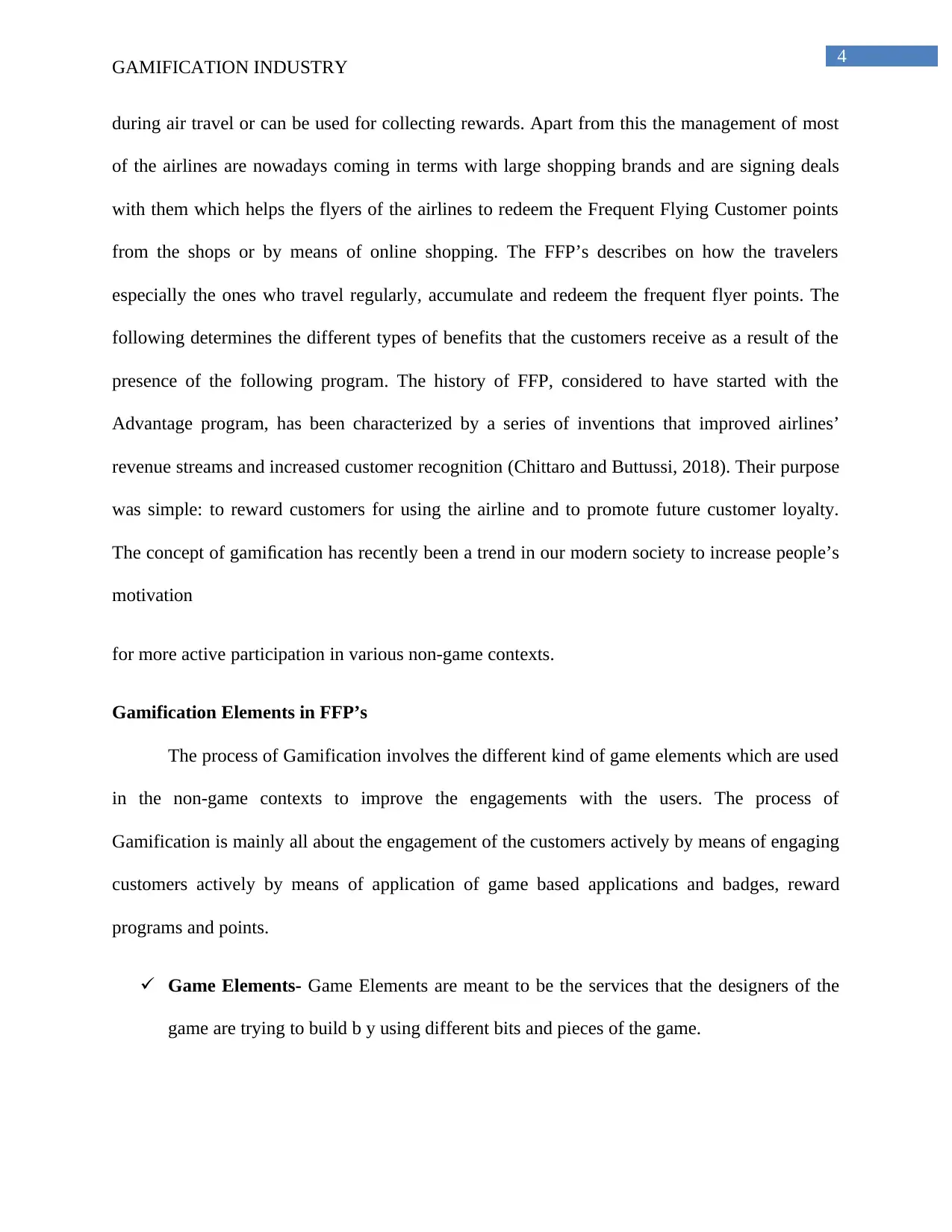
4
GAMIFICATION INDUSTRY
during air travel or can be used for collecting rewards. Apart from this the management of most
of the airlines are nowadays coming in terms with large shopping brands and are signing deals
with them which helps the flyers of the airlines to redeem the Frequent Flying Customer points
from the shops or by means of online shopping. The FFP’s describes on how the travelers
especially the ones who travel regularly, accumulate and redeem the frequent flyer points. The
following determines the different types of benefits that the customers receive as a result of the
presence of the following program. The history of FFP, considered to have started with the
Advantage program, has been characterized by a series of inventions that improved airlines’
revenue streams and increased customer recognition (Chittaro and Buttussi, 2018). Their purpose
was simple: to reward customers for using the airline and to promote future customer loyalty.
The concept of gamification has recently been a trend in our modern society to increase people’s
motivation
for more active participation in various non-game contexts.
Gamification Elements in FFP’s
The process of Gamification involves the different kind of game elements which are used
in the non-game contexts to improve the engagements with the users. The process of
Gamification is mainly all about the engagement of the customers actively by means of engaging
customers actively by means of application of game based applications and badges, reward
programs and points.
Game Elements- Game Elements are meant to be the services that the designers of the
game are trying to build b y using different bits and pieces of the game.
GAMIFICATION INDUSTRY
during air travel or can be used for collecting rewards. Apart from this the management of most
of the airlines are nowadays coming in terms with large shopping brands and are signing deals
with them which helps the flyers of the airlines to redeem the Frequent Flying Customer points
from the shops or by means of online shopping. The FFP’s describes on how the travelers
especially the ones who travel regularly, accumulate and redeem the frequent flyer points. The
following determines the different types of benefits that the customers receive as a result of the
presence of the following program. The history of FFP, considered to have started with the
Advantage program, has been characterized by a series of inventions that improved airlines’
revenue streams and increased customer recognition (Chittaro and Buttussi, 2018). Their purpose
was simple: to reward customers for using the airline and to promote future customer loyalty.
The concept of gamification has recently been a trend in our modern society to increase people’s
motivation
for more active participation in various non-game contexts.
Gamification Elements in FFP’s
The process of Gamification involves the different kind of game elements which are used
in the non-game contexts to improve the engagements with the users. The process of
Gamification is mainly all about the engagement of the customers actively by means of engaging
customers actively by means of application of game based applications and badges, reward
programs and points.
Game Elements- Game Elements are meant to be the services that the designers of the
game are trying to build b y using different bits and pieces of the game.
Secure Best Marks with AI Grader
Need help grading? Try our AI Grader for instant feedback on your assignments.
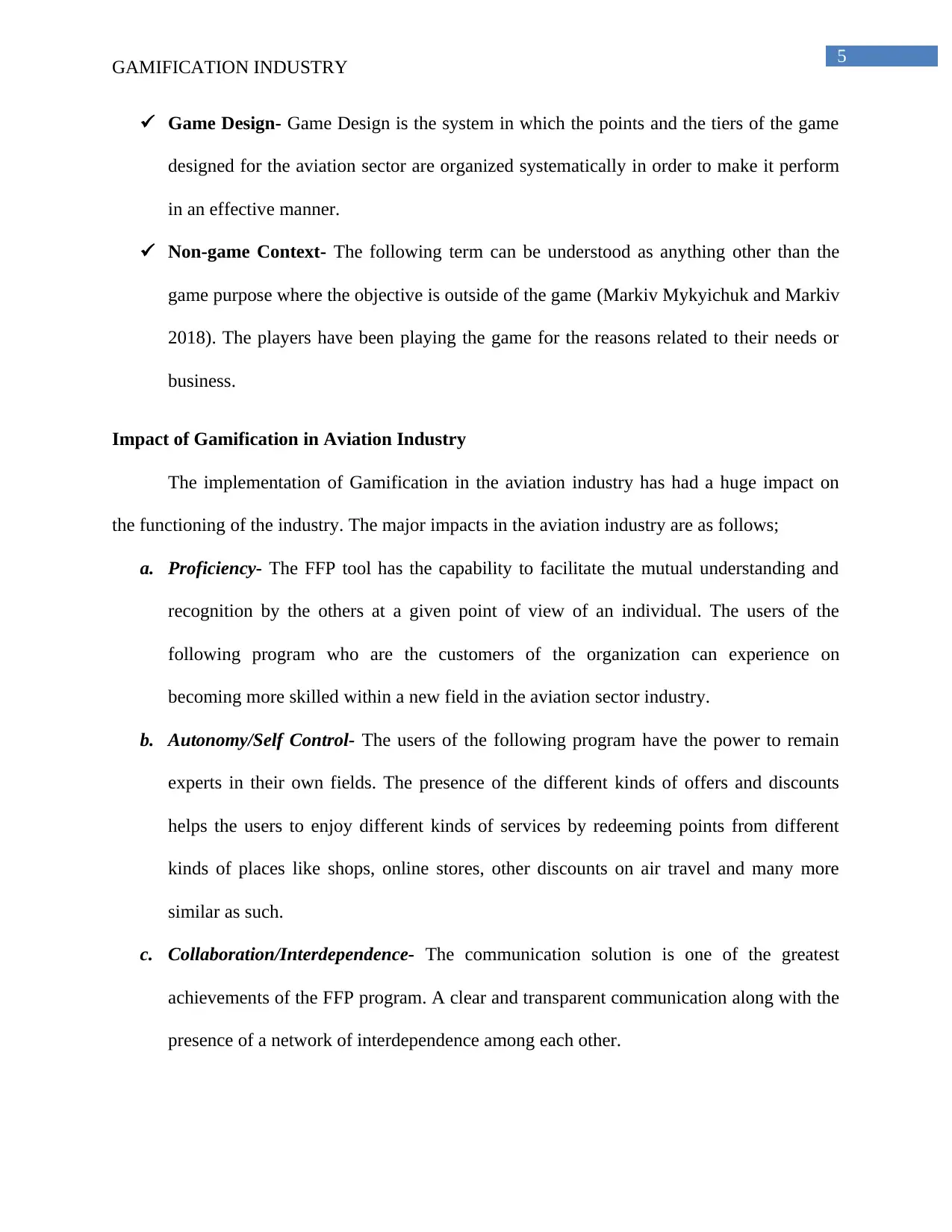
5
GAMIFICATION INDUSTRY
Game Design- Game Design is the system in which the points and the tiers of the game
designed for the aviation sector are organized systematically in order to make it perform
in an effective manner.
Non-game Context- The following term can be understood as anything other than the
game purpose where the objective is outside of the game (Markiv Mykyichuk and Markiv
2018). The players have been playing the game for the reasons related to their needs or
business.
Impact of Gamification in Aviation Industry
The implementation of Gamification in the aviation industry has had a huge impact on
the functioning of the industry. The major impacts in the aviation industry are as follows;
a. Proficiency- The FFP tool has the capability to facilitate the mutual understanding and
recognition by the others at a given point of view of an individual. The users of the
following program who are the customers of the organization can experience on
becoming more skilled within a new field in the aviation sector industry.
b. Autonomy/Self Control- The users of the following program have the power to remain
experts in their own fields. The presence of the different kinds of offers and discounts
helps the users to enjoy different kinds of services by redeeming points from different
kinds of places like shops, online stores, other discounts on air travel and many more
similar as such.
c. Collaboration/Interdependence- The communication solution is one of the greatest
achievements of the FFP program. A clear and transparent communication along with the
presence of a network of interdependence among each other.
GAMIFICATION INDUSTRY
Game Design- Game Design is the system in which the points and the tiers of the game
designed for the aviation sector are organized systematically in order to make it perform
in an effective manner.
Non-game Context- The following term can be understood as anything other than the
game purpose where the objective is outside of the game (Markiv Mykyichuk and Markiv
2018). The players have been playing the game for the reasons related to their needs or
business.
Impact of Gamification in Aviation Industry
The implementation of Gamification in the aviation industry has had a huge impact on
the functioning of the industry. The major impacts in the aviation industry are as follows;
a. Proficiency- The FFP tool has the capability to facilitate the mutual understanding and
recognition by the others at a given point of view of an individual. The users of the
following program who are the customers of the organization can experience on
becoming more skilled within a new field in the aviation sector industry.
b. Autonomy/Self Control- The users of the following program have the power to remain
experts in their own fields. The presence of the different kinds of offers and discounts
helps the users to enjoy different kinds of services by redeeming points from different
kinds of places like shops, online stores, other discounts on air travel and many more
similar as such.
c. Collaboration/Interdependence- The communication solution is one of the greatest
achievements of the FFP program. A clear and transparent communication along with the
presence of a network of interdependence among each other.
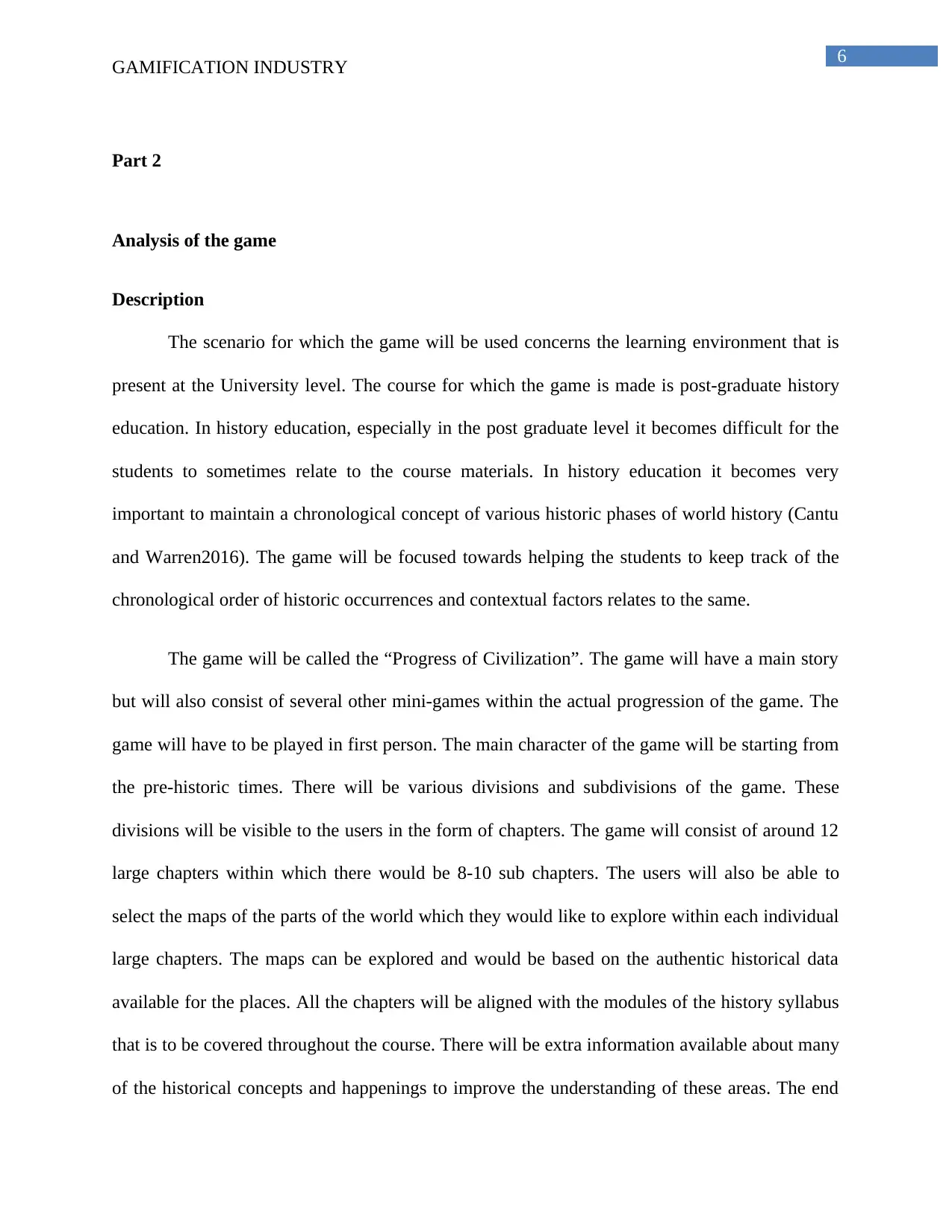
6
GAMIFICATION INDUSTRY
Part 2
Analysis of the game
Description
The scenario for which the game will be used concerns the learning environment that is
present at the University level. The course for which the game is made is post-graduate history
education. In history education, especially in the post graduate level it becomes difficult for the
students to sometimes relate to the course materials. In history education it becomes very
important to maintain a chronological concept of various historic phases of world history (Cantu
and Warren2016). The game will be focused towards helping the students to keep track of the
chronological order of historic occurrences and contextual factors relates to the same.
The game will be called the “Progress of Civilization”. The game will have a main story
but will also consist of several other mini-games within the actual progression of the game. The
game will have to be played in first person. The main character of the game will be starting from
the pre-historic times. There will be various divisions and subdivisions of the game. These
divisions will be visible to the users in the form of chapters. The game will consist of around 12
large chapters within which there would be 8-10 sub chapters. The users will also be able to
select the maps of the parts of the world which they would like to explore within each individual
large chapters. The maps can be explored and would be based on the authentic historical data
available for the places. All the chapters will be aligned with the modules of the history syllabus
that is to be covered throughout the course. There will be extra information available about many
of the historical concepts and happenings to improve the understanding of these areas. The end
GAMIFICATION INDUSTRY
Part 2
Analysis of the game
Description
The scenario for which the game will be used concerns the learning environment that is
present at the University level. The course for which the game is made is post-graduate history
education. In history education, especially in the post graduate level it becomes difficult for the
students to sometimes relate to the course materials. In history education it becomes very
important to maintain a chronological concept of various historic phases of world history (Cantu
and Warren2016). The game will be focused towards helping the students to keep track of the
chronological order of historic occurrences and contextual factors relates to the same.
The game will be called the “Progress of Civilization”. The game will have a main story
but will also consist of several other mini-games within the actual progression of the game. The
game will have to be played in first person. The main character of the game will be starting from
the pre-historic times. There will be various divisions and subdivisions of the game. These
divisions will be visible to the users in the form of chapters. The game will consist of around 12
large chapters within which there would be 8-10 sub chapters. The users will also be able to
select the maps of the parts of the world which they would like to explore within each individual
large chapters. The maps can be explored and would be based on the authentic historical data
available for the places. All the chapters will be aligned with the modules of the history syllabus
that is to be covered throughout the course. There will be extra information available about many
of the historical concepts and happenings to improve the understanding of these areas. The end
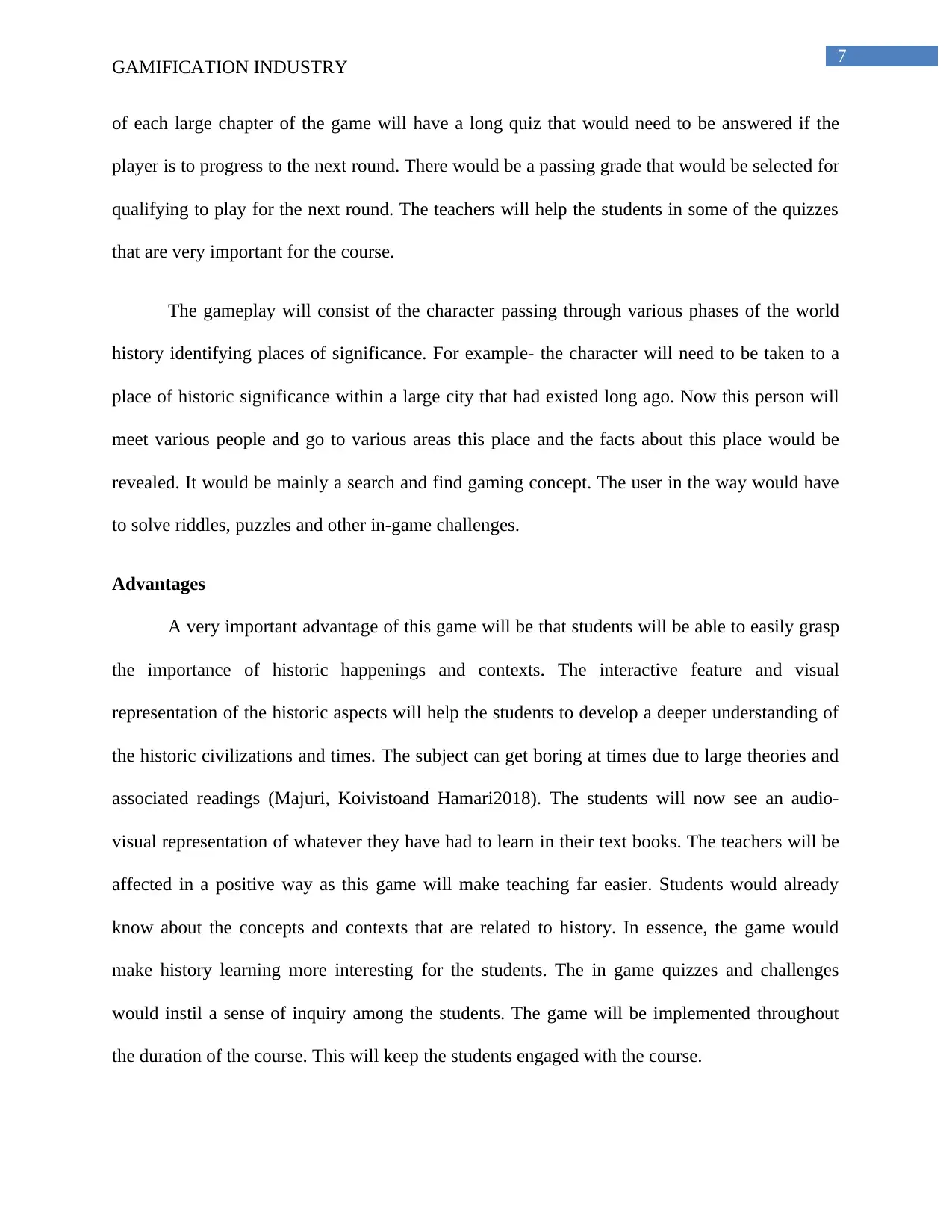
7
GAMIFICATION INDUSTRY
of each large chapter of the game will have a long quiz that would need to be answered if the
player is to progress to the next round. There would be a passing grade that would be selected for
qualifying to play for the next round. The teachers will help the students in some of the quizzes
that are very important for the course.
The gameplay will consist of the character passing through various phases of the world
history identifying places of significance. For example- the character will need to be taken to a
place of historic significance within a large city that had existed long ago. Now this person will
meet various people and go to various areas this place and the facts about this place would be
revealed. It would be mainly a search and find gaming concept. The user in the way would have
to solve riddles, puzzles and other in-game challenges.
Advantages
A very important advantage of this game will be that students will be able to easily grasp
the importance of historic happenings and contexts. The interactive feature and visual
representation of the historic aspects will help the students to develop a deeper understanding of
the historic civilizations and times. The subject can get boring at times due to large theories and
associated readings (Majuri, Koivistoand Hamari2018). The students will now see an audio-
visual representation of whatever they have had to learn in their text books. The teachers will be
affected in a positive way as this game will make teaching far easier. Students would already
know about the concepts and contexts that are related to history. In essence, the game would
make history learning more interesting for the students. The in game quizzes and challenges
would instil a sense of inquiry among the students. The game will be implemented throughout
the duration of the course. This will keep the students engaged with the course.
GAMIFICATION INDUSTRY
of each large chapter of the game will have a long quiz that would need to be answered if the
player is to progress to the next round. There would be a passing grade that would be selected for
qualifying to play for the next round. The teachers will help the students in some of the quizzes
that are very important for the course.
The gameplay will consist of the character passing through various phases of the world
history identifying places of significance. For example- the character will need to be taken to a
place of historic significance within a large city that had existed long ago. Now this person will
meet various people and go to various areas this place and the facts about this place would be
revealed. It would be mainly a search and find gaming concept. The user in the way would have
to solve riddles, puzzles and other in-game challenges.
Advantages
A very important advantage of this game will be that students will be able to easily grasp
the importance of historic happenings and contexts. The interactive feature and visual
representation of the historic aspects will help the students to develop a deeper understanding of
the historic civilizations and times. The subject can get boring at times due to large theories and
associated readings (Majuri, Koivistoand Hamari2018). The students will now see an audio-
visual representation of whatever they have had to learn in their text books. The teachers will be
affected in a positive way as this game will make teaching far easier. Students would already
know about the concepts and contexts that are related to history. In essence, the game would
make history learning more interesting for the students. The in game quizzes and challenges
would instil a sense of inquiry among the students. The game will be implemented throughout
the duration of the course. This will keep the students engaged with the course.
Paraphrase This Document
Need a fresh take? Get an instant paraphrase of this document with our AI Paraphraser
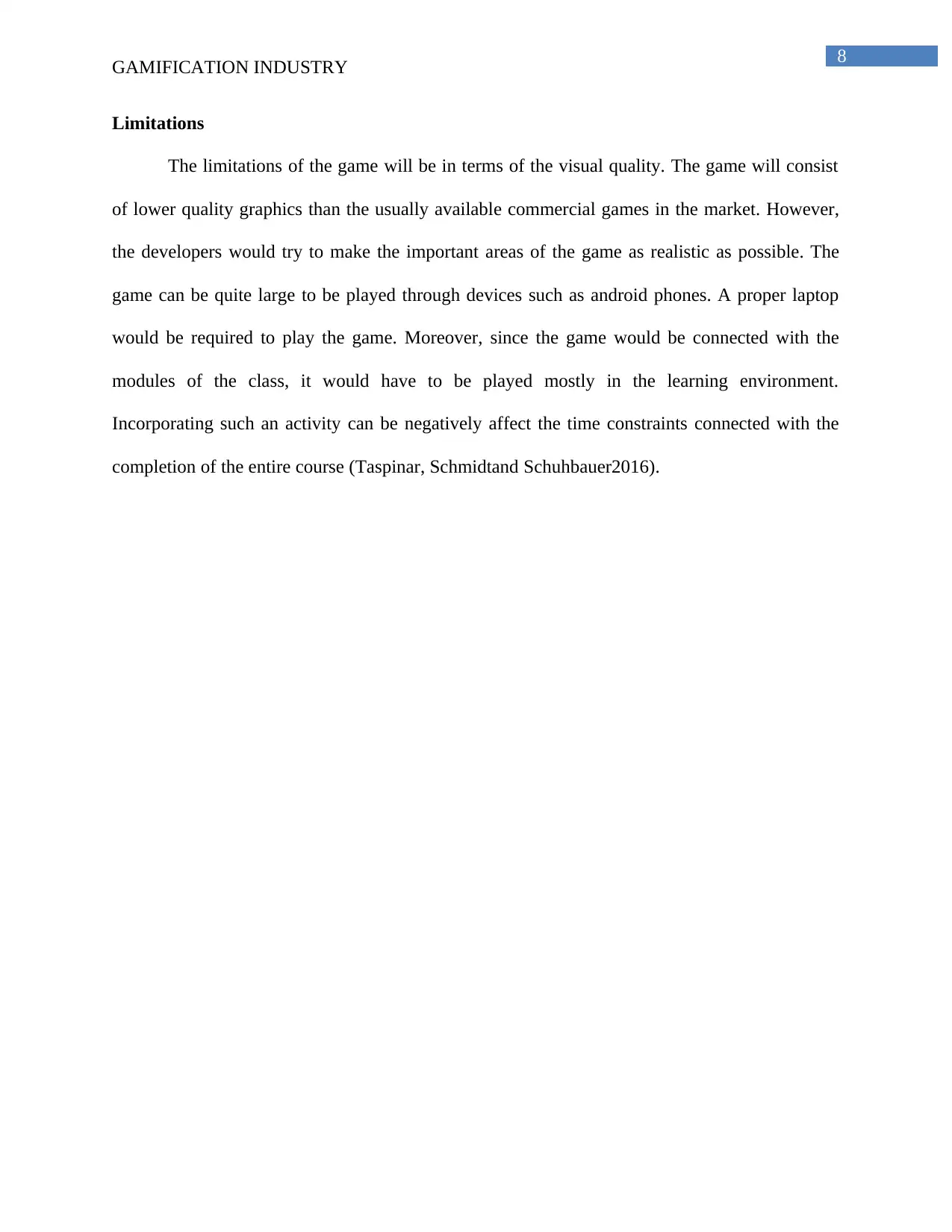
8
GAMIFICATION INDUSTRY
Limitations
The limitations of the game will be in terms of the visual quality. The game will consist
of lower quality graphics than the usually available commercial games in the market. However,
the developers would try to make the important areas of the game as realistic as possible. The
game can be quite large to be played through devices such as android phones. A proper laptop
would be required to play the game. Moreover, since the game would be connected with the
modules of the class, it would have to be played mostly in the learning environment.
Incorporating such an activity can be negatively affect the time constraints connected with the
completion of the entire course (Taspinar, Schmidtand Schuhbauer2016).
GAMIFICATION INDUSTRY
Limitations
The limitations of the game will be in terms of the visual quality. The game will consist
of lower quality graphics than the usually available commercial games in the market. However,
the developers would try to make the important areas of the game as realistic as possible. The
game can be quite large to be played through devices such as android phones. A proper laptop
would be required to play the game. Moreover, since the game would be connected with the
modules of the class, it would have to be played mostly in the learning environment.
Incorporating such an activity can be negatively affect the time constraints connected with the
completion of the entire course (Taspinar, Schmidtand Schuhbauer2016).
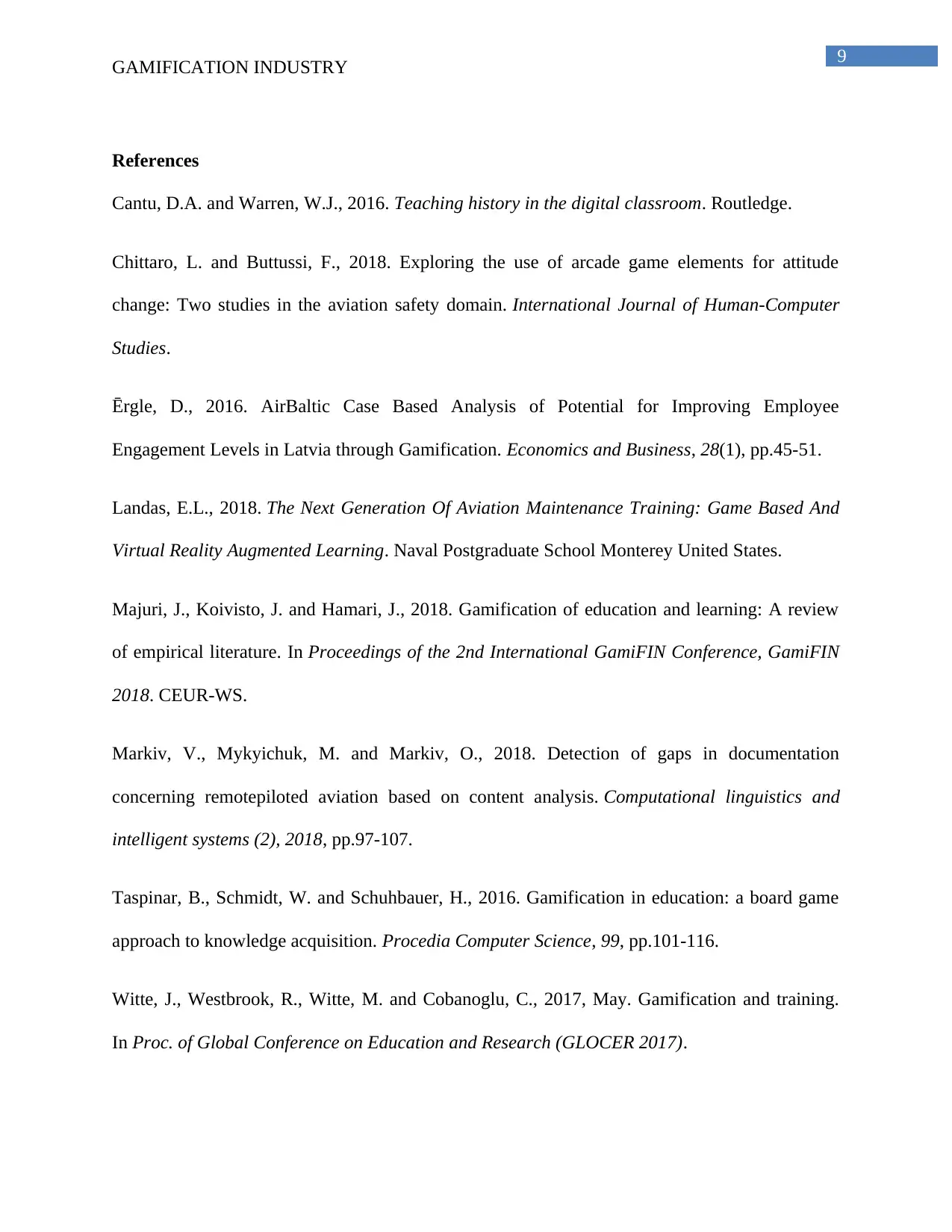
9
GAMIFICATION INDUSTRY
References
Cantu, D.A. and Warren, W.J., 2016. Teaching history in the digital classroom. Routledge.
Chittaro, L. and Buttussi, F., 2018. Exploring the use of arcade game elements for attitude
change: Two studies in the aviation safety domain. International Journal of Human-Computer
Studies.
Ērgle, D., 2016. AirBaltic Case Based Analysis of Potential for Improving Employee
Engagement Levels in Latvia through Gamification. Economics and Business, 28(1), pp.45-51.
Landas, E.L., 2018. The Next Generation Of Aviation Maintenance Training: Game Based And
Virtual Reality Augmented Learning. Naval Postgraduate School Monterey United States.
Majuri, J., Koivisto, J. and Hamari, J., 2018. Gamification of education and learning: A review
of empirical literature. In Proceedings of the 2nd International GamiFIN Conference, GamiFIN
2018. CEUR-WS.
Markiv, V., Mykyichuk, M. and Markiv, O., 2018. Detection of gaps in documentation
concerning remotepiloted aviation based on content analysis. Computational linguistics and
intelligent systems (2), 2018, pp.97-107.
Taspinar, B., Schmidt, W. and Schuhbauer, H., 2016. Gamification in education: a board game
approach to knowledge acquisition. Procedia Computer Science, 99, pp.101-116.
Witte, J., Westbrook, R., Witte, M. and Cobanoglu, C., 2017, May. Gamification and training.
In Proc. of Global Conference on Education and Research (GLOCER 2017).
GAMIFICATION INDUSTRY
References
Cantu, D.A. and Warren, W.J., 2016. Teaching history in the digital classroom. Routledge.
Chittaro, L. and Buttussi, F., 2018. Exploring the use of arcade game elements for attitude
change: Two studies in the aviation safety domain. International Journal of Human-Computer
Studies.
Ērgle, D., 2016. AirBaltic Case Based Analysis of Potential for Improving Employee
Engagement Levels in Latvia through Gamification. Economics and Business, 28(1), pp.45-51.
Landas, E.L., 2018. The Next Generation Of Aviation Maintenance Training: Game Based And
Virtual Reality Augmented Learning. Naval Postgraduate School Monterey United States.
Majuri, J., Koivisto, J. and Hamari, J., 2018. Gamification of education and learning: A review
of empirical literature. In Proceedings of the 2nd International GamiFIN Conference, GamiFIN
2018. CEUR-WS.
Markiv, V., Mykyichuk, M. and Markiv, O., 2018. Detection of gaps in documentation
concerning remotepiloted aviation based on content analysis. Computational linguistics and
intelligent systems (2), 2018, pp.97-107.
Taspinar, B., Schmidt, W. and Schuhbauer, H., 2016. Gamification in education: a board game
approach to knowledge acquisition. Procedia Computer Science, 99, pp.101-116.
Witte, J., Westbrook, R., Witte, M. and Cobanoglu, C., 2017, May. Gamification and training.
In Proc. of Global Conference on Education and Research (GLOCER 2017).
1 out of 9
Related Documents
Your All-in-One AI-Powered Toolkit for Academic Success.
+13062052269
info@desklib.com
Available 24*7 on WhatsApp / Email
![[object Object]](/_next/static/media/star-bottom.7253800d.svg)
Unlock your academic potential
© 2024 | Zucol Services PVT LTD | All rights reserved.





